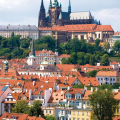PRAGUE CASTLE (PRAŽSKÝ HRAD)
If you only have to see one thing, then it should be the castle! It is the largest residence of a head of state.
Considered by the Guinness Book to be the largest residence of a head of state, the Château measures 1 km from east to west and around 400 m from north to south. Every era has contributed to the construction of this prestigious complex. All architectural styles coexist on this slate mound, creating an unforgettable panorama. Symbolizing the evolution of a people, the Castle was built in 870, when the first Bohemian prince, Bořivoj, built a stronghold around a wooden structure. It evolved through the fires, constructions and remodeling carried out by its various occupants, but its current appearance mainly reflects the work undertaken under Empress Maria Theresa, from 1740 to 1780. With the advent of the First Republic, President Masaryk commissioned the architect Plecnik to make the necessary alterations to transform the castle into a presidential residence. His work was the last major conversion of the castle, since the Communists left it more or less abandoned after the war. It wasn't until the Velvet Revolution that the château once again became the residence of the President of the Republic, as well as an exhibition space for the National Gallery.
There are two ways toget there. Either follow the flow of visitors from Mala Strana up Nerudova Street to Castle Square, or go through Letna Park and enter the courtyard via the small Prašnybridge. But here again, even if the route through the park is rather pleasant and the views unseen, you won't avoid the crowds before reaching the courtyard.
First courtyard. This is the main entrance to the Castle, the court of honor or ceremonies. Every day at noon, summer and winter alike, you'll witness the "grand" changing of the guard, a well-ordered ballet lasting around 20 minutes and involving the 40 or so guards assigned to watch over the Château. The monumental gate separating the first courtyard from the square is surmounted by giants sculpted by I. Platzer. They symbolize the battle of the Titans. To the left of the main courtyard are the "gardens on the bastion"(zahrada na bašté) designed by Jože Plečnik in the 1930s. The Mathias Gate is the oldest remaining part of the castle. It stood on the ramparts and gave access to the castle until Plečnik decided to create two entrances to bypass it, as he felt it symbolized the past domination of the Austro-Hungarian Empire, incompatible with the spirit of the First Republic. Note on the left the grand staircase of the Plečnik Room: this is the major work of this architect, who was commissioned to design part of the Château and its gardens between 1920 and 1930. It leads to the famous Spanish Room and the Galerie Rodolphe. These rooms, all stuccoed and gilded, are sometimes open to the public (for concerts, for example). Don't miss this opportunity for a fleeting glimpse into the world of the Habsburgs..
Second courtyard. This courtyard was created on the site of a former suburb in the 16thcentury , then transformed in 1775 by N. Pacassi during the reign of Maria Theresa. At the center of the courtyard is a beautiful Baroque fountain dating from 1686 and a Renaissance well. This courtyard leads to the Castle Gallery (open Tuesday to Sunday, 10 a.m. to 4 p.m.), which today houses works by Tintoretto, Titian, Rubens and others. In the south-east corner, the Sainte-Croix chapel houses the treasure of Saint-Guy cathedral: a unique collection of liturgical objects collected since the 10thcentury . This is also where tourists are now welcomed.
Third courtyard. Dominated by the side of Saint-Guy Cathedral, this courtyard is built on the remains of Romanesque and Gothic houses. Work undertaken in 1929 has left part of the cathedral exposed (see below), which commands attention in this courtyard, dominated by its high spires overhanging its golden door. Don't forget to use a wide-angle lens for your photos, as there's very little distance between you and the monument. The monolith, which rises over 16 m, is the work of Plečnik, dedicated to the memory of the victims of the First World War. The equestrian statue represents St. George slaying the dragon. It dates from 1373. On the tower, two clocks, one on top of the other, indicate the hours and the other the minutes. A visit to the Gothic halls of the old royal palace, once inhabited by the kings of Bohemia, is a must. Go straight to the 62 m-long Vladislav Hall, where coronation banquets and knights' tournaments were held. More recently, in 1948, it was the venue for the election of President Clement Gottwald, followed by that of Gustav Husak in 1975.
Which tour to choose? That depends above all on the time you have available. Prague Castle is a very large complex, worth spending at least half a day at. But if you're an art lover, the galleries of the Pinakothek (currently being refurbished) will also keep you busy for a while, even if they're not as well-stocked as they were in Rudolf II's day. If you've got some juice in your legs, buy the extra ticket for access to one of the cathedral's spires (150 Kč).
Did you know? This review was written by our professional authors.
Members' reviews on PRAGUE CASTLE (PRAŽSKÝ HRAD)
The ratings and reviews below reflect the subjective opinions of members and not the opinion of The Little Witty.
L'intérieur du chateau est décevant, les pièces sont vides et ne présente pas grand intêret.
La ruelle d'or est sympathique avec sa reconstitution des diférents métiers
















Il y a plusieurs bâtiments à visiter et un billet combiné est une bonne opportunité même si c'est relativement cher. Nous avons beaucoup aimé la ruelle d'or.